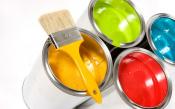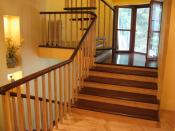Search
Login
Spray paints, types and application, useful tips
The paint we use in everyday life to give the objects around us a more aesthetic appearance is available in the form of powders, oil mixtures, suspensions. Recently, the so-called. aerosol paints enclosed in a very convenient compact spray can. The history of aerosols is quite old, it begins with the invention of a siphon for aerating water. Further, this technology was used to improve the application of wax on the ski surface; during this time, the siphon was transformed into a can with a valve. And only in 1927 an attempt was made to apply paint using the aforementioned method. The name aerosol itself arose because of the dispersed state of the paint - inside the container it is in the form of tiny particles and when sprayed it looks like fog.
Content
- Spray paint - reasons for popularity
- Application area
- Material benefits
- Basic principles for choosing spray paints
- How to apply spray paints video
- Intended use of aerosols of various types
Spray paint - reasons for popularity

The reasons for the popularity of spray paints become quite understandable when studying the instructions for their use. When applying such paints there are no problems with hard-to-reach surfaces. At the end of the work, it is not necessary to clean used tools, which minimizes material loss. Spray paint in spray cans does not require the purchase of expensive solvents or color mixing before use. When injecting paint into cylinders, inert chemical components are used that create excess pressure. Sale of paint is carried out in a ready-to-use form, shades are selected in accordance with the codes. Preparation for work lasts for 30 seconds and consists in shaking the can - during this time the ball inside will bring the paint into a uniform state.
Application area
Spray paints are ideal for:
- restoration work
- decorating rooms or individual objects,
- creating images using stencils,
- painting surfaces of any complexity,
- creating graffiti.
In addition, spray paint is widely used:
- in the automotive and repair industries,
- when performing construction and finishing works,
- in the sector engaged in the production of heating and heating appliances.

Material benefits
Among the positive qualities of aerosol paints include:
- ease of transportation
- lack of special storage requirements, its long term,
- excellent adhesion to surfaces of various quality,
- the possibility of obtaining a uniform layer,
- resistance to sunlight and abrasion, to high and low temperatures,
- it is convenient to store incompletely used cylinders - they do not exude an odor, and the paint does not dry out in them.
Different types of paints are available in the form of aerosols:
- acrylic
- oil
- latex
- heat resistant
- epoxy
- water repellent impregnation,
- primers.

Thanks to the extensive color palette, it is easy to find the right shade of paint. You can also select paint
- glossy, semi-glossy or matte,
- with rainbow stains or pearlescent,
- with diamond dust effect or fluorescent shine.
Spray paints for decor - a product highly sought after by interior designers, their interest is caused by materials that allow:
- imitate the hammer effect,
- texture of various materials
- metal surfaces.

The use of aerosols allows the creation of a smooth transition of shades.
Among the shortcomings, recall:
- the inability to mix shades, however, any of them can be bought ready-made,
- you will need to acquire some working skills: applying too thick a layer of paint will lead to sagging,
- to get a clear border you will need to use a stencil or masking tape,
- the inability to adjust the thickness of the paint with a solvent,
- to work on the street you need calm, calm weather.
Basic principles for choosing spray paints

So that as a result of applying the paint a quality and resistant to destructive effects surface is obtained, the rules of choice should be followed. The dye must match the material on which it will be applied:
- acrylic spray paint is suitable for glass, wooden or plastic surfaces;
- zinc-aluminum - for metal;
- epoxy - for enameled or ceramic.
The choice of the desired shade should be carried out according to catalogs such as RAL or NCS. Special effects created by paint should be chosen in accordance with the general style of the decorated interior item. The calculation of the amount of material can be carried out according to the data on the consumption of paint per 1 sq. M, you should also take into account the planned number of applied layers.
How to apply spray paints

The second prerequisite for the quality of painting will be compliance with the rules for its application. It is recommended to work in a respirator and goggles - to avoid poisoning. Before painting, you need to prepare the surface: remove dirt from it, degrease it with alcohol or acetone. Surfaces that are not to be painted should be sealed with masking tape. If the material to be painted is porous, it is first treated with a primer. Drains should be removed until they are dry, with a clean rag. Before applying the paint, the can should be shaken several times - the consistency of the paint from this will become uniform. Test staining is performed on a foreign object. The distance from the spray can to the surface to be painted should be about 25 cm. When applying paint, the uniformity of the layer to be created is monitored - exceeding the required amount will cause sagging. To work outdoors, it is better to choose a cloudy, quiet day.
If possible, the surface to be painted should be placed horizontally, if you need to apply paint on a vertical surface, then the coating is performed from top to bottom, this will prevent the paint from dripping. If the paint is applied in several layers, then before applying the next one you need to wait about half an hour. Before you start using the painted product, you must make sure that it is completely dry, this may take about a day. To fix the paint on the surface, you can apply a thin layer of acrylic varnish.
Do not spray paint near a fire - their mixture with air is a highly flammable substance. Work at temperatures above +50 degrees is prohibited. A high-quality surface will be obtained if the soil, paint and varnish from the same manufacturer are used in its creation.
Spray paints should not be given to children as a toy. It can be used only in well-ventilated areas.
Intended use of aerosols of various types

eco enamels
The basis of such paints is water, they can be used for interior and exterior decoration. Such paint is applied and dries quickly, accidentally falling on surrounding objects, the paint can be removed with a damp rag for half an hour. The dried eco-paint creates a durable coating that does not change color under the sun. Ecokrask has a pronounced vanilla odor.
spray paints for metal

On sale there are three varieties of paints for metal:
- consisting of three components - a rust, soil and paint converter,
- two-component - from a primer and paint,
- conventional, designed to give the surface the desired color.

Complex paints are more expensive, but they save time on preparatory work - the metal will only need to be cleaned with a metal brush or sandpaper. Use of aerosols for metal:
- simplifies the process of painting complex and hard-to-reach surfaces,
- allows you to save on paint consumption,
- provides a high degree of corrosion protection.
spray paint for cars

It turns out to be indispensable if necessary to paint over scuffs or scratches on the body. Any driver can do the restoration of his paintwork with his own hands, moreover, efficiently and quickly. The most popular brands in the market of car paints are COLOMIX, DUPLI-COLOR, MOTIP, MAXI color, etc.
The chemical composition of automotive paints may vary, depending on it, the paint is divided into:
- alkyd enamels, characterized by rapid polymerization at ordinary temperature and pressure, used in local repair;
- melamine-alkyd enamels, the application of which requires a high temperature (about 110-130 degrees), characterized by a wealth of shades, the ability to create special effects; the drying time at high temperature caused the use of melamide-alkyd paints in the factory or at specialized enterprises;
- acrylic, the most common, quickly hardening, creating glossy and matte surfaces, resistant to aggressive environments and not requiring varnish coating. Among the disadvantages are the rather high cost of the material.

Aerosol enamels allow you to create interesting effects on a painted surface: in addition to a glossy or matte look, they can look like metal, a chameleon or mother of pearl.
spray paint

The basis of heat-resistant aerosols are organosilicon compounds. In their composition they also contain polymer components and pigments, fillers. Heat-resistant paints are not afraid of exposure to high temperatures, vapors and chemicals. This type of paint is intended for application to ceramic, metal, brick and concrete surfaces; it is used to cover the surfaces of stoves and fireplaces, engines, boilers, and all kinds of building structures. Walls cover it in saunas and pools, bath rooms.
A type of thermal paint, characterized by the ability to accumulate light, is used to decorate road signs, fire protection equipment, certain types of dishes.
It is possible to carry out work using such paint at a temperature not lower than -15 and not higher than + 40C. Drying time depending on humidity and temperature can last about two weeks.
spray paint for plastic

Resistant to chemicals and high humidity, has high wear resistance. Depending on the composition, it can create a surface: glossy, rough or velvety. Hiding power also depends on the composition - the amount of material consumed per unit area.
Paints for plastic are divided into several types:
- polyarylate (polymer), with excellent adhesion, including a primer with enamel qualities;
- abrasion resistant, created on the basis of polyurethane resins, their use allows you to create a glossy surface;
- structural, with good thixotropy, hiding minor surface defects, giving it perfect smoothness;
- Soft touch, a special acrylic-polyurethane composition that creates a velvety surface;
- designed for painting polyvinyl chloride surfaces, well-held on them and providing protection from ultraviolet radiation;
- monadic based on modified alkyd-polyvinyl chloride resins used for application to polyvinyl chloride surfaces.
spray paints for decor

Decorative aerosols have many shades, they should be selected by numbers in the corresponding table. It should be borne in mind that the composition of the paint must correspond to the base on which it will be applied. With the help of this type of paints, the decor of double-glazed windows, jars or flasks is performed, while creating rather complex patterns. In this case, the use of stencils or masking tape is practiced.

It is mandatory to prepare the surface - clean it of dirt, dry, limit the area to be painted, degrease its surface, apply paint, and if necessary, apply the next layer after a quarter of an hour. Masking tape can be removed after 40 minutes.
fabric spray paint

Using them allows you to perform original painting on fabric - batik, it can be used to create drawings in free technique or using a stencil, it can be used to paint large-sized panels. The composition of the tissues can be natural or contain no more than 20% synthetic impurities.
Popular textile sprays, such as Marabu Textil Design, are available in a very wide range of colors, spray cans from 100 to 200 ml, this volume is enough to create a pattern on one piece of clothing.
Textile paints are characterized by a high hiding power, they fit well on the fabric surface, they do not contain substances harmful to humans.

To apply paint:
- to wash and iron the fabric,
- isolate the other side of the product, excluding accidental contact with paint,
- shake the bottle several times
- when spraying paint, the can should be kept at a distance of 5 cm from the product,
- dry the product for 30 minutes.
Washing a painted or stained product should be done in water with a temperature below +30 C.
The use of textile dyes allows you to decorate clothing items and create original drawings on textiles used for interior decoration, for example - on curtain fabric.






